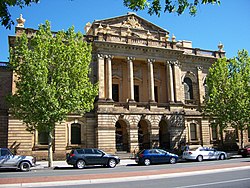Australia is somewhat unique among the international community, in that when it was colonized by the British in the 18th and 19th centuries, it was used as a penal colony. This means that to deal with its overcrowded prisons, Great Britain shipped prisoners to Australia as punishment. It is estimated that between 1788 and 1868, the British government sent around 162,000 prisoners to the various penal colonies set up. Approximately 20% of Australians living today are descended from convicts shipped over from Great Britain. It will be interesting to see how this history affects Australian views of criminal justice.

The vast majority of the community policing in Australia is done by state police forces. Every state and territory has its own police force responsible for enforcing the laws of that state. The Australian Federal Police (AFP) is responsible for enforcing federal law and investigating crimes that happen across the country, such as drug trafficking. It also does community policing in several of Australia’s territories. The AFP is like the rough equivalent of the FBI in the United States. Despite very strict gun control laws, Australian police usually carry guns while on duty. From 1989 until 2011, there were 105 fatal shootings by police. In addition, all fatal police shootings are automatically subject to an internal review, and are monitored by the Australian Institute of Criminology’s National Deaths in Custody Program.
In many respects, the court system of Australia is very similar to that of the United States. Like with the police system, Australia has state/territorial courts, and federal courts. State court handle cases dealing with state law, while federal courts handle cases dealing with federal law. People arrested in Australia have the right to remain silent, which they must be told upon arrest, similar to the Miranda warnings given in the United States. All defendants are considered innocent until proven guilty; the burden of proof is on the prosecution. The defendants also have the “privilege against self-incrimination.” One notable difference between the courts of the U.S. and the courts of Australia is that they abolished the death penalty in the 1970s.

Over the past couple of years, Australia has started to experience some prison overcrowding of its own. In the last two decades, Australia’s prison population has more than doubled, and now, the prisons in every state and territory except for Tasmania are overflowing. The growth has been attributed to laws passed recently by the state and federal governments to appear “tougher” on crime, and set mandatory minimum sentences for some offenses. Despite the prisons being above capacity, many states and territories have also been ignoring calls to construct more prisons to deal with the influx. Australia also has a number of for-profit prisons, run by private corporations.
It has been interesting to look at Australia’s criminal justice system because it’s so similar to that of the United States. It’s also interesting that Australia seems to be heading down the same street as us. Calls from the government to get tougher on crime seem eerily similar to calls from the American government shortly before the War on Drugs began and mass incarceration became a problem. Now what’s troublesome is that these policies are being implemented even though the United States is a perfect example of similar policies not working. The United States has tried getting tough on crime, and has found that it does not work, and now Australia is seemingly ignoring that message and trying it anyway.
The United States could probably learn a thing or two from Australia on police shootings. Despite also having a police force that carries guns, the yearly number of fatal police shootings in Australia has only reached the double digits once since 1989, while in the U.S., there have been over 800 fatal police shootings thus far in 2015. This difference could be attributed to a number of different factors, such as far stricter gun control laws, and differences in cultural understandings of the role of police. The United States could also learn from Australia’s example in the 20th century, because before they tried to get tougher on crime, Australia had a relatively low incarceration rate.

